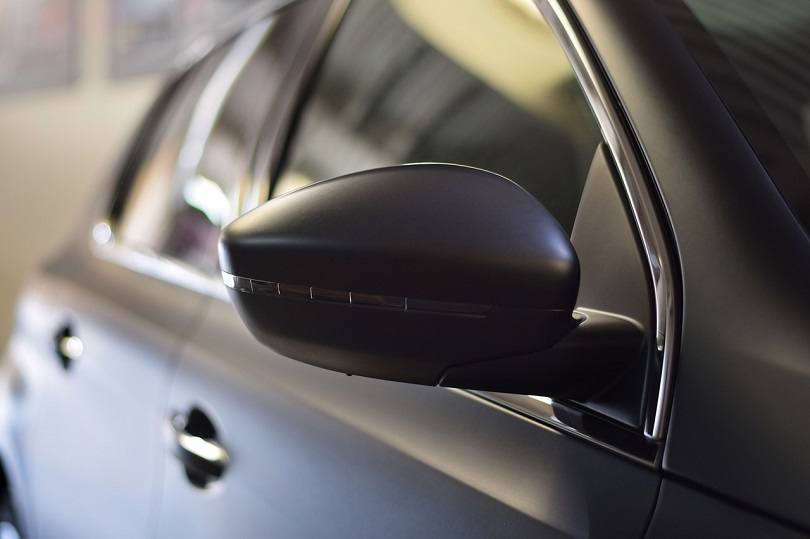7 Different Types of Car Wraps (with Pictures)
-
Kristin Hitchcock
- Last updated:

While vehicle wraps aren’t terribly common, they are extremely versatile. Instead of painting a car all over again, vehicle wraps can quickly change the color of your car— and often for much less money. You can also add all sorts of different graphics without needing to pay tons of money for someone else to paint them.
There are tons of different options out there but below, we’ve taken a look at some of the most common types of car wraps. You can utilize this range of car wraps for all sorts of different reasons.
 The 7 Different Types of Car Wraps
The 7 Different Types of Car Wraps
1. Full Wraps

- Uses: Color change
Usually, full wraps are used to change the color of a car completely without actually repainting it. Not only is this color change extremely inexpensive when compared to painting, but it is also completely reversible. Most of the time, these wraps are a solid color.
You can even wrap a car in the same color it already is to protect the paint underneath.
Because they are so much larger, these wraps are a bit more expensive than other wraps. However, they create a permanent look over the whole car, so you’re getting what you pay for.
- Inexpensive
- Reversible
- Completely changes the color
- Protects the paint underneath
- Expensive
2. Commercial Wraps
- Uses: Marketing purposes
Commercial wraps are often put on commercial vehicles for marketing purposes. These cars are usually branded, which is much easier with a wrap. Instead of paying a company to paint all the letters and logos on a car, many companies use commercial wraps.
These wraps can be done as both full and partial wraps, depending on the look the company is going for.
As you might imagine, these are not very common for personal use.
- Inexpensive advertising
- Easier than painting
- Not ideal for personal vehicles
3. Partial Wraps
- Uses: Details
A partial wrap only covers some of the vehicles. Usually, the hood, roof, trunk, and doors are flat areas that are often used. These wraps are typically used for details since they don’t cover the whole car and are much more subtle than other wraps out there.
Partial wraps are sometimes used for promotional purposes. For instance, a company may put its logo on the hood of a company car, as opposed to wrapping the whole car.
As you’d expect, these partial wraps are less expensive since they are small and don’t require as much time to put on.
- Less expensive
- Great for details
- Only covers part of the car
4. Carbon Fiber Wraps
- Uses: Protection
Usually, car wraps are made from vinyl. However, carbon fiber wraps are available too. Usually, these provide an interesting texture and are only available in matte grey colors. However, they are extremely resistant to damage, which is often why they are used—most people utilize them as a protective wrap, protecting the car’s paint and body underneath.
Carbon fiber wraps are also more difficult to apply and full wraps are often expensive. Plus, they don’t look like real paint when inspected closely.
- Resistant to damage
- Provides a matte grey color
- Expensive
- Only one color is available
- Difficult to apply
5. Chrome Wraps
- Uses: Flashy aesthetics
Most people can’t afford to get their car covered in actual chrome. However, you can get a chrome wrap that looks like the real thing. Obviously, these wraps are extremely flashy but if that’s what you’re going for, then this is a great option.
However, this wrap is much more difficult to apply as it is much heavier. You’ll typically need to use a professional, and they may charge you more to apply it.
As an added benefit, chrome wraps do not absorb much heat. Therefore, they keep your car from getting quite as hot. In some areas, this benefit is more than enough to justify the cost.
- Reflects heat
- Flashy aesthetics
- Expensive
6. Cast Vinyl
- Uses: Flexibility
A cast vinyl wrap is exactly what it sounds like – it is plastic that is cast in a mold. It tends to be much stronger and far more durable. It’s often made to be extremely thin is easier to fit in smaller places.
As you might expect, this type of vinyl is often used for smaller places.
- Flexible
- Can be used in smaller places
- Expensive
7. Calendared Vinyl

- Uses: Budget Option
This sort of vinyl is made by heating it and pressing it. This process is much less expensive than casting and is often considered a budget option.
However, it is not as strong as other options out there. For this reason, it is often made thicker so that it can withstand the elements. Despite this, it is one of the most popular options, largely because of its price.
- Inexpensive
- Not very strong
 Conclusion
Conclusion
There are tons of different vehicle wraps out there which are all used for different reasons. If you want a wrap to protect your car, you’re going to get something different than if you want to advertise your company on a company van. For this reason, you must be careful in choosing the correct vehicle wrap—they don’t all do the same thing.
By educating yourself on the type of wrap you want, you’ll ensure the job ends up how you want it. While some of these wraps can be done by the average car owner, we do recommend using a professional in most cases.
- See Also: Car Paint: How to Choose the Right Type
Featured Image Credit: CreaPark, Pixabay
Contents
 The 7 Different Types of Car Wraps
The 7 Different Types of Car Wraps